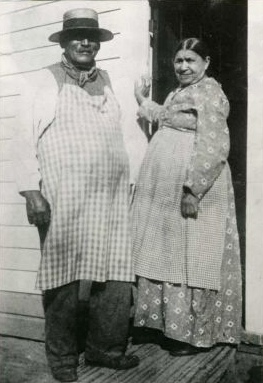George Speck facts for kids
Quick facts for kids
George Crum
|
|
|---|---|

George Speck with his sister "Aunt Kate" Wicks
|
|
| Born |
George Speck
July 15, 1824 |
| Died | July 22, 1914 (aged 90) Malta, New York, U.S.
|
| Occupation | Chef |
| Parent(s) | Abraham Speck, Diana Tull |
George Speck (also known as George Crum; July 15, 1824 – July 22, 1914) was an American chef. He served thinly sliced fried potatoes at his restaurants, which became known as "Saratoga chips".
After his death, a local legend developed which credited Speck with the invention of potato chips. The first published recipes for potato chips date from the early 19th century, decades before Speck's career as a chef. Nonetheless, the myth spread and was featured in national advertising campaigns in the 1970s.
Early life
Speck was born on July 15, 1824 in Saratoga County in upstate New York. He did not have the opportunity to go to school and didn't receive proper education.
Early career
Speck developed his culinary skills at Cary Moon's Lake House on Saratoga Lake. It was as an expensive restaurant at a time when wealthy families from Manhattan and other areas were building summer "camps" in the area. Speck and his sister, Wicks, also cooked at the Sans Souci in Ballston Spa.
By 1860, Speck had opened his own restaurant, called Crum's, on Storey Hill in nearby Malta, New York. His cuisine was in high demand among Saratoga Springs' tourists and elites: "His prices were…those of the fashionable New York restaurants, but his food and service were worth it…Everything possible was raised on his own small farm, and that, too, got his personal attention whenever he could arrange it."
Potato chip
Speck's sister recalled the invention of Saratoga Chips as an accident: she had "chipped off a piece of the potato which, by the merest accident, fell into the pan of fat. She fished it out with a fork and set it down upon a plate beside her on the table." Her brother tasted it, declared it good, and said, "We'll have plenty of these." In a 1932 interview with the Saratogian newspaper, her grandson, John Gilbert Freeman, asserted Wicks's role as the true inventor of the potato chip.
Interesting facts about George Speck
- Speck was a member of the Mohawk people.
- In his youth he worked as a hunter, guide and cook in the Adirondack Mountains.
- One of the regular customers at Cary Moon's Lake House was shipping tycoon Cornelius Vanderbilt, who could never seem to remember Speck's name. On one occasion, he called a waiter over to ask "Crum", "How long before we shall eat?" Rather than take offense, Speck decided to embrace the nickname, figuring that, "A crumb is bigger than a speck."
- According to popular accounts, Speck included a basket of chips on every table in his restaurant.
- A 1973 advertising campaign by the St. Regis Paper Company, which manufactured packaging for chips, featured an ad for Speck and his story, published in the national magazines, Fortune and Time.

